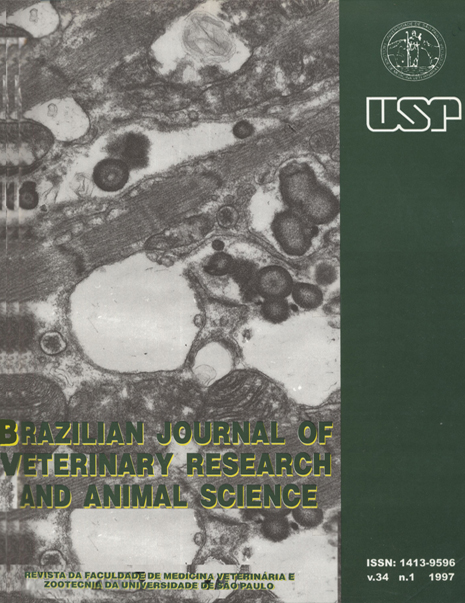Ultrastructural changes in the myocardium in the experimental poisoning of rabbits by calcinogenic plant Solanum malacoxylon
DOI:
https://doi.org/10.11606/issn.2318-3659.v34i1p21-25Keywords:
Calcification, Myocardium, Poisonous plants, Rabbits, Plant poisoningAbstract
Six rabbits of both sexes, 3-months old, were given via gastric tube an aqueous extract of the plant Solanum malacoxylon, equivalent to 100 mg of dried leaves per kg of body weight. Two rabbits (controls) did not receive the extract and were killed at the end of the experiment. All others rabbits were killed at 48,72 and 120 hours after extract administration. Fragments of myocardium were sampled and processed for both light and electron microscopy. Most significant gross changes observed were whitish streaks in the myocardium, especially in the right atrium. On light microscopic examination, groups of muscle cells had swollen sarcoplasms with loss of striations, slight basophila and eventual sarcoplasmic vacuolizations. These groups of cells were usually surrounded by macrophages, mesenchymal cells and few neutrophils admixed with necrotic debris. There was a delicate granular basophilic material in the interstitium. Von Kossa staining revealed, at these sites, calcium deposits within the sarcoplasm of cardiac myocytes in the interstitium and,occasionally, around apparently non damaged myocytes. There was mineralization of the medial tunic of coronary arteries. On the EM
examination the following changes were observed: activation of cardiac myocytes and interstitial cells, calcium deposits in the interstitium
and in the sarcosplasm of cardiac myocytes, as well as in the cytoplasm of interstitial cells. In late stages there was necrosis of cardiac myocytes, with mineralization and cytolisis. Few neutrophils and macrophages, with phagocytized mineral necrotic debris were also observed at these sites. The morphological aspect of the myocardium suggests that necrosis and calcification result from the direct action of the 1,25(OH)2D3 present in the plant on the myocardial cells. No changes in the myocardium of control rabbits were found.
Downloads
Download data is not yet available.
Downloads
Published
1997-02-01
Issue
Section
ANIMAL PATHOLOGY
License
The journal content is authorized under the Creative Commons BY-NC-SA license (summary of the license: https://
How to Cite
1.
Marçolla ED da C, Barros CSL de, Barros SS de, Russowsky D. Ultrastructural changes in the myocardium in the experimental poisoning of rabbits by calcinogenic plant Solanum malacoxylon. Braz. J. Vet. Res. Anim. Sci. [Internet]. 1997 Feb. 1 [cited 2024 Apr. 23];34(1):21-5. Available from: https://revistas.usp.br/bjvras/article/view/50232





